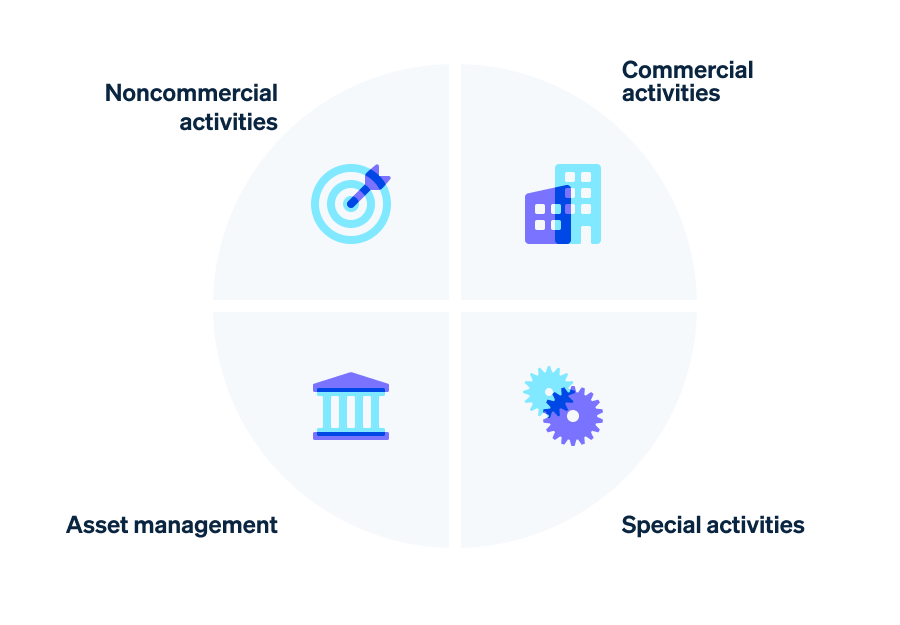ในปี 2022 มีการจดทะเบียนสมาคมมากกว่า 615,000 สมาคม ในเยอรมนี และจำนวนนี้ยังคงเพิ่มขึ้นอย่างต่อเนื่อง สมาคมได้รับความนิยมเนื่องจากสามารถเชื่อมโยงผู้คนที่มีความสนใจร่วมกันได้ นอกจากนี้ สมาคมยังได้รับประโยชน์มากมาย เช่น การลดหย่อนภาษีและเงินทุนจากรัฐบาล อย่างไรก็ตาม สิ่งสำคัญคือต้องทราบว่าสมาคมต้องปฏิบัติตามข้อกำหนดทางกฎหมายหลายประการในการปฏิบัติทางบัญชี
ในบทความนี้ เราจะพิจารณาข้อกำหนดทางบัญชีสำหรับสมาคมและสรุปหลักการของการบัญชีที่ถูกต้องเหมาะสม นอกจากนี้เรายังจะกล่าวถึงผู้ที่จัดการบัญชีในสมาคม ว่าสมาคมสามารถจัดการสมุดบัญชีของตนเองได้หรือไม่ และผลกระทบที่อาจเกิดขึ้นจากการบัญชีที่ไม่ถูกต้อง นอกจากนี้ เรายังจะให้เคล็ดลับที่จะช่วยคุณลดความซับซ้อนของกระบวนการบัญชีของสมาคมของคุณด้วย
เนื้อหาหลักในบทความ
- ข้อกำหนดทางบัญชีพื้นฐานสำหรับสมาคมมีอะไรบ้าง
- หลักการของการบัญชีที่เหมาะสมคืออะไร
- ใครเป็นผู้รับผิดชอบบัญชีของสมาคม
- สมาคมสามารถจัดการบัญชีของตนเองได้หรือไม่
- อะไรคือผลที่ตามมาของข้อผิดพลาดในบัญชีของสมาคม
- การบัญชีของสมาคมจะง่ายขึ้นได้อย่างไร
ข้อกำหนดทางบัญชีพื้นฐานสำหรับสมาคมมีอะไรบ้าง
ในทางกฎหมาย สมาคมที่จดทะเบียนแล้ว หมายถึง “สมาคมใดๆ ก็ตาม โดยไม่คำนึงถึงโครงสร้างทางกฎหมาย โดยที่สมาชิกส่วนใหญ่ ไม่ว่าจะเป็นบุคคลธรรมดาหรือนิติบุคคล ได้มารวมตัวกันโดยสมัครใจเพื่อบรรลุเป้าหมายร่วมกันเป็นระยะเวลานาน และปฏิบัติตามกระบวนการตัดสินใจที่เป็นระเบียบ” (ดูมาตรา 2 วรรค 1 ของกฎหมายสมาคม)
ไม่ว่าจะเป็นสโมสรกีฬา สโมสรยิงปืน หรือองค์กรไม่แสวงหาผลกำไร สมาคมต่างๆ ถือเป็นนิติบุคคลตามกฎหมายและต้องปฏิบัติตามข้อกำหนดทางบัญชีของสมาคม ซึ่งเป็นไปตามข้อกำหนดด้านภาษีตามกฎหมายและข้อบังคับของสมาคม โดยที่ประชุมใหญ่สามารถขอให้มีการตรวจสอบการเงินของสมาคมได้ รวมถึงสำนักงานภาษีก็สามารถตรวจสอบรายได้และรายจ่ายได้เช่นกัน โดยรายได้และรายจ่ายจะแบ่งออกเป็นสี่ประเภทดังต่อไปนี้
- กิจกรรมที่ไม่ใช่เชิงพาณิชย์: หมวดหมู่นี้ครอบคลุมกิจกรรมที่ไม่ใช่เชิงพาณิชย์ที่เกี่ยวข้องโดยตรงกับพันธกิจของสมาคม ซึ่งรวมถึงค่าธรรมเนียมสมาชิก พร้อมกับรายได้จากการบริจาค ของขวัญ และมรดกต่างๆ ส่วนรายจ่ายในหมวดหมู่นี้อาจเป็นค่าใช้จ่ายในการบริหาร ค่าเช่าสถานที่ของสโมสร หรือค่าเบี้ยเลี้ยงสำหรับผู้ฝึกสอนต่างๆ
- _กิจกรรมเชิงพาณิชย์: _ ซึ่งรวมถึงกิจกรรมที่สร้างรายได้ใดๆ ที่อยู่นอกเหนือวัตถุประสงค์ที่ระบุไว้ของสมาคม ตัวอย่างเช่น รายได้ในหมวดหมู่นี้อาจมาจากการขายอาหารและเครื่องดื่มในงานอีเวนต์ต่างๆ
- กิจกรรมพิเศษ: กิจกรรมพิเศษคือการดำเนินการภายในสมาคมที่สนับสนุนวัตถุประสงค์ทางกฎหมายและเป็นกุญแจสำคัญในการบรรลุวัตถุประสงค์ ข้อบังคับของสมาคมทำให้ถึงความแตกต่างจากกิจกรรมเชิงพาณิชย์ ตัวอย่างเช่น รายได้อาจมาจากการขายบัตรเข้าร่วมกิจกรรมของสมาคม ส่วนรายจ่ายต่างๆ อาจเป็นค่าใช้จ่ายต่างๆ เช่น ค่าเช่าอุปกรณ์หรือการจ้างเจ้าหน้าที่ผู้เชี่ยวชาญสำหรับงานนั้นๆ
- _การจัดการสินทรัพย์: _ การจัดการสินทรัพย์เกี่ยวข้องกับรายได้จากกิจกรรมต่างๆ เช่น การเช่าหรือให้เช่าซื้อทรัพย์สินที่เป็นของสมาคม การเช่าพื้นที่โฆษณา เช่น บนยานพาหนะที่เป็นของสมาคม ก็อาจสร้างรายได้ได้เช่นกัน ส่วนรายจ่ายต่างๆ อาจรวมถึงค่าบำรุงรักษาอาคารหรือค่าประกันภัย และค่าธรรมเนียมบัญชีธนาคารต่างๆ
ขอบเขตกิจกรรมในสมาคม

สมาคมต้องเริ่มทำบัญชีทันทีที่จดทะเบียนและดำเนินกิจกรรมเชิงพาณิชย์ ไม่ว่าจะแสวงหากำไรหรือไม่ก็ตาม ธุรกรรมทางธุรกิจทั้งหมดต้องได้รับการบันทึกอย่างละเอียด ซึ่งรวมถึงรายได้และรายจ่ายทั้งหมด ตลอดจนถึงเงินสดและยอดคงเหลือในบัญชี โดยบัญชีต้องรวมรายการทรัพย์สินของสมาคมต่างๆ เช่น อสังหาริมทรัพย์ ยานพาหนะ อุปกรณ์ เครื่องจักร หรือห้องปฏิบัติการที่สมาคมเป็นเจ้าของด้วย
สมาคมต้องจัดทำและยื่นแบบแสดงรายการภาษีของสมาคมภายในกำหนดเวลา สำหรับสมาคมขนาดเล็กที่มีผลประกอบการและกำไรที่สามารถจัดการได้ การทำบัญชีแบบเกณฑ์เงินสด (ที่เรียกว่า "Einnahmenüberschussrechnung" หรือ "EÜR") ก็เพียงพอแล้ว (ดูมาตรา 4 วรรค 3 ของพระราชบัญญัติภาษีเงินได้) หากผลประกอบการประจำปีของสมาคมเกิน 600,000 ยูโร หรือมีกำไรต่อปีมากกว่า 60,000 ยูโร สมาคมจะต้องใช้ระบบการทำบัญชีคู่สำหรับการบัญชี
การเก็บใบเสร็จหรือเอกสารประกอบการทำธุรกรรมทุกครั้งเป็นสิ่งที่มีความสำคัญในการตรวจสอบรายได้และรายจ่าย เนื่องจากสมาคมต้องปฏิบัติตามหลักการบัญชีที่ถูกต้องเหมาะสมเช่นเดียวกับบริษัท
หลักการบัญชีที่เหมาะสมคืออะไร
หลักการบัญชีที่เหมาะสมเวอร์ชันล่าสุดมีผลบังคับใช้ตั้งแต่ปี 2020 เรียกว่า GoBD ซึ่งในภาษาเยอรมันย่อมาจาก "Grundsätze zur ordnungsmäßigen Führung und Aufbewahrung von Büchern, Aufzeichnungen und Unterlagen in elektronischer Form sowie zum Datenzugriff" โดยข้อบังคับจากกระทรวงการคลังแห่งสหพันธ์สาธารณรัฐเยอรมนีนี้จะกำหนดหลักการพื้นฐานสำหรับการบัญชีดิจิทัลของเอกสารที่เกี่ยวข้องกับภาษีที่บังคับใช้กับทั้งบริษัทและสมาคมต่างๆ
หลักการสำคัญของ GoBD คือ
- ความสามารถในการตรวจสอบย้อนกลับและการยืนยันผลลัพธ์: การบัญชีของสมาคมจะต้องสมบูรณ์ ชัดเจน และกระชับ
- _ความสมบูรณ์: _ ทุกธุรกรรมทางธุรกิจต้องได้รับการบันทึกตามระยะเวลาเก็บรักษา ใบเสร็จสำหรับรายได้และรายจ่ายจะต้องระบุวันที่ จำนวนเงิน ปริมาณ หมายเลขใบเสร็จ รวมถึงผู้ออกและผู้รับ
- _ความถูกต้อง: _ ธุรกรรมทางธุรกิจทั้งหมดต้องได้รับการบันทึกอย่างถูกต้องและสะท้อนถึงธุรกรรมจริง ใบเสร็จรับเงินที่เกี่ยวข้องจะถูกเก็บถาวรไว้เพื่อวัตถุประสงค์นี้
- รายการและบันทึกที่ตรงเวลา: การบันทึกที่ตรงเวลาเป็นสิ่งสำคัญสำหรับการบัญชีที่ถูกต้อง ธุรกรรมทางธุรกิจทั้งหมดควรได้รับการบันทึกทันทีหลังจากที่เกิดขึ้น โดยกฎหมายกำหนดให้บันทึกธุรกรรมที่ไม่ใช่เงินสดภายใน 10 วัน ในขณะที่การรับและการเบิกจ่ายเงินสดต้องทำการบันทึกทุกวัน
- _ความเป็นระเบียบเรียบร้อย: _ ควรเก็บรักษาบันทึกเพื่อให้บุคคลภายนอกสามารถเข้าใจการบัญชีของสมาคมได้โดยง่าย ซึ่งอาจรวมถึงผู้สอบบัญชีหรือที่ปรึกษาด้านภาษี การบัญชีอย่างเป็นระบบจะแยกความแตกต่างระหว่างธุรกรรมเงินสดและธุรกรรมที่ไม่ใช่เงินสดได้ และยังจำแนกประเภทการขายว่าเป็นรายการที่ต้องเสียภาษี ปลอดภาษี หรือไม่ต้องเสียภาษีได้ โดยใบเสร็จทั้งหมดต้องสามารถอ่านด้วยเครื่องได้
- การที่ไม่สามารถแก้ไขได้: เอกสารทางบัญชีต้องได้รับการจัดเก็บในลักษณะที่มั่นใจได้ว่าไม่สามารถเปลี่ยนแปลงหรือแก้ไขได้ หากมีการเปลี่ยนแปลงใดๆ ในภายหลัง จะต้องบันทึกเอกสารเหล่านั้นอย่างโปร่งใส เอกสารที่แก้ไขใดๆ จะต้องได้รับการบันทึกใหม่ โดยกฎหมายกำหนดให้ต้องมีประวัติของเวอร์ชันด้วย
การบัญชีของสมาคมจะสอดคล้องกับ GoBD ก็ต่อเมื่อปฏิบัติตามหลักการเหล่านี้ คุณสามารถหาข้อมูลเพิ่มเติมได้ในบทความของเราเกี่ยวกับ GoBD
ใครเป็นผู้รับผิดชอบบัญชีของสมาคม
คณะกรรมการมีหน้าที่รับผิดชอบในการจัดทำบัญชีของสมาคมและดูแลให้เป็นไปตามหลักการบัญชีที่ถูกต้องเหมาะสม เนื่องจากคณะกรรมการมีหน้าที่จัดการดูแลทรัพย์สินและธุรกิจของสมาคม จึงมีหน้าที่ดูแลและรับผิดชอบ ซึ่งรวมถึงความรับผิดชอบต่างๆ เช่น การให้ข้อมูลแก่ที่ประชุมใหญ่ โดยทั่วไป คณะกรรมการจะปฏิบัติตามภาระหน้าที่นี้เป็นประจำทุกปีโดยการนำเสนองบการเงินของสมาคมสำหรับปีที่ผ่านมา โดยข้อกำหนดนี้มีรายละเอียดอยู่ในข้อบังคับของสมาคม
คณะกรรมการมักจะแต่งตั้งเหรัญญิกเพื่อดูแลทางการเงิน และอาจมีการแต่งตั้งผู้สอบบัญชีด้วย อย่างไรก็ตาม แม้ในสถานการณ์เช่นนี้ คณะกรรมการยังคงเป็นผู้รับผิดชอบแต่เพียงผู้เดียวในการจัดทำบัญชีที่มีความถูกต้องแม่นยำ
สมาคมสามารถจัดการบัญชีของตนเองได้หรือไม่
สมาคมสามารถจัดการบัญชีของตนเองได้ วิธีนี้เหมาะอย่างยิ่งสำหรับสมาคมขนาดเล็กที่มีสมาชิกน้อยและมีผลประกอบการที่สามารถจัดการได้ โดยไม่จำเป็นต้องมีความรู้ความเชี่ยวชาญในสถานการณ์นี้ อย่างไรก็ตาม ผู้รับผิดชอบควรมีความเข้าใจพื้นฐานเกี่ยวกับการทำบัญชี เช่นเดียวกับการจัดทำแบบแสดงรายการภาษีเงินได้
ในสถานการณ์นี้ การใช้ซอฟต์แวร์บัญชีเฉพาะทางที่ช่วยลดความยุ่งยากในขั้นตอนการดำเนินการถือเป็นความคิดที่ดี สิ่งสำคัญคือซอฟต์แวร์ต้องปฏิบัติตามหลักการบัญชีที่ถูกต้องเหมาะสม ข้อดีหลักของการใช้ซอฟต์แวร์คือสามารถจัดการงานประจำวันต่างๆ ให้เป็นอัตโนมัติได้
งานเหล่านี้ประกอบด้วยการจัดทำงบกำไรขาดทุน การจัดการรายได้และรายจ่าย การบันทึกรายการธุรกรรมในหมวดหมู่เฉพาะและกำหนดไว้ในบัญชีต่างๆ การจัดทำใบแจ้งหนี้ ใบเสร็จรับเงินบริจาค หรือการแจ้งเตือน และการวางแผนงบประมาณของสมาคม นอกจากนี้ ซอฟต์แวร์จะอัปเดตโดยอัตโนมัติเพื่อให้เป็นไปตามข้อกำหนดด้านกฎระเบียบใหม่ๆ โดยทั่วไปค่าใช้จ่ายจะอยู่ระหว่างสิบถึงหลายร้อยดอลลาร์ต่อปี ขึ้นอยู่กับจำนวนสมาชิกที่บริหารจัดการหรือผู้ที่สามารถเข้าถึงโปรแกรมได้
อย่างไรก็ตาม สำหรับสมาคมที่มีรายได้สูง มีสมาชิก พนักงาน หรืออสังหาริมทรัพย์จำนวนมาก การจัดการบัญชีอย่างอิสระอาจกลายเป็นความท้าทายที่สำคัญได้อย่างรวดเร็ว ในกรณีเช่นนี้ การขอความช่วยเหลือจากบุคคลที่สามและการจ้างนักบัญชีจากภายนอกจึงเป็นเรื่องที่สมเหตุสมผล โดยอาจพิจารณาใช้บริการจากผู้ให้บริการหรือนักบัญชีเฉพาะทางสำหรับงานนี้
Stripe Billing สามารถช่วยคุณในการออกใบแจ้งหนี้ตามแบบแผนล่วงหน้าสำหรับสมาชิกของคุณได้ และยังช่วยจัดการเวิร์กโฟลว์ให้เป็นอัตโนมัติ รวมถึงช่วยลดภาระงานที่ต้องทำด้วยตนเองได้ นอกจากนี้ คุณยังสามารถจัดการบัญชีของคุณและเข้าถึงรายละเอียดทางการเงินและรายงานรายรับได้โดยตรงจากแดชบอร์ด ทำให้การบัญชีของคุณง่ายขึ้นมาก โดยคุณยังสามารถอนุญาตให้ลูกค้าของคุณจัดการการสมัครใช้งานของตนได้อย่างอิสระผ่านพอร์ทัลลูกค้า
การประเมินต้นทุนและงบประมาณทางบัญชีเป็นรายกรณีเป็นสิ่งที่มีความสำคัญ ซึ่งสามารถใช้โซลูชันแบบไฮบริดได้เช่นกัน โดยจะจ้างบุคคลภายนอกเฉพาะธุรกรรมบางรายการ แทนที่จะจ้างสำหรับกระบวนการทางบัญชีทั้งหมด นอกจากการรับค่าธรรมเนียมสมาชิกแล้ว สมาคมต่างๆ ยังสามารถใช้ Stripe เพื่อจัดการการขายสินค้าและบริการให้กับผู้ที่ไม่ใช่สมาชิก หรือเพื่อรวบรวมเงินบริจาคได้อีกด้วย
อะไรคือผลที่ตามมาของข้อผิดพลาดในบัญชีของสมาคม
สมาคมต่างๆ จะต้องปฏิบัติตาม GoBD และต้องปฏิบัติตามกำหนดเวลา มิฉะนั้น อาจมีค่าใช้จ่ายเกิดขึ้นสูงได้
การผิดกำหนดเวลาอาจส่งผลให้ต้องเสียค่าธรรมเนียมและดอกเบี้ยสำหรับยอดค้างชำระ สมาคมควรรวบรวมข้อมูลให้ครบถ้วนเพื่อให้มั่นใจว่าเอกสารทั้งหมดได้รับการส่งครบถ้วนและตรงเวลา หากไม่สามารถดำเนินการตามกำหนดเวลาได้ ขอแนะนำให้ติดต่อสำนักงานภาษีเพื่อปรึกษาหารือเกี่ยวกับสถานการณ์ โดยปกติสำนักงานภาษีพร้อมให้ความร่วมมือเมื่อได้รับแจ้งอย่างทันท่วงที
หากสำนักงานภาษีพบข้อบกพร่องทางบัญชีระหว่างการตรวจสอบบัญชี อาจมีการออกการประเมินเพิ่มเติม เพื่อเป็นพื้นฐานที่เหมาะสมสำหรับการจัดเก็บภาษี รายได้หรือค่าใช้จ่ายที่หายไปจะถูกประเมินตามความน่าจะเป็นสูงสุด ปัญหาจะยิ่งรุนแรงมากขึ้นหากสมาคมถูกสงสัยว่าหลีกเลี่ยงภาษี ในสถานการณ์เช่นนี้ มีความเสี่ยงที่จะถูกปรับเป็นเงินจำนวนมาก และสมาชิกคณะกรรมการอาจต้องรับผิดชอบส่วนตัวด้วยทรัพย์สินของตนเอง นอกจากนี้ยังมีความเป็นไปได้ว่าอาจต้องโทษจำคุกสูงสุด 10 ปี
การบัญชีของสมาคมจะง่ายขึ้นได้อย่างไร
การได้รับสถานะองค์กรไม่แสวงหาผลกำไรสามารถทำให้การบัญชีสำหรับสมาคมง่ายขึ้น เนื่องจากสมาคมที่ไม่แสวงหาผลกำไรจะได้รับการยกเว้นจากภาษีการค้า ภาษีเงินได้นิติบุคคล และภาษีมูลค่าเพิ่ม (VAT) อย่างไรก็ตาม โดยข้อกำหนดนี้จะใช้ได้เฉพาะในกรณีที่สมาคมเหล่านั้นมีคุณสมบัติตรงตามเกณฑ์เดียวกันกับกฎของผู้ประกอบการขยายธุรกิจรายย่อย: ผลประกอบการรายปีในปีก่อนหน้าต้องไม่เกิน 22,000 ยูโร และต้องน้อยกว่า 50,000 ยูโร ในปีงบประมาณปัจจุบัน
นอกจากนี้ สมาคมไม่แสวงหากำไรยังสามารถหักเงินบริจาคเพื่อวัตถุประสงค์ทางภาษีได้ เนื่องจากมีสิทธิ์ออกใบเสร็จรับเงินบริจาค ข้อดีอีกประการหนึ่งสำหรับสมาคมไม่แสวงหากำไรคือสามารถขอรับเงินทุนจากรัฐบาลได้ อย่างไรก็ตาม เงินทุนดังกล่าวจะต้องถูกนำไปใช้เพื่อวัตถุประสงค์เฉพาะและต้องมีหลักฐานยืนยันอย่างชัดเจน โดยสถานะองค์กรไม่แสวงหากำไรมีข้อดีและความสะดวกในการดำเนินการหลายประการ แต่ก็จำเป็นต้องมีการบันทึกข้อมูลอย่างละเอียดมากขึ้นด้วยเช่นกัน
ในช่วงไม่กี่ปีที่ผ่านมา การเปลี่ยนผ่านสู่ระบบดิจิทัลทำให้การบัญชีสำหรับทุกสมาคมง่ายขึ้น โดยโซลูชันเฉพาะทาง อย่างเช่น Stripe Billing ช่วยทำให้กระบวนการบัญชีนั้นง่ายขึ้น ช่วยเพิ่มประสิทธิภาพ และความโปร่งใส ลดภาระงานที่ต้องทำด้วยตนเอง เช่น การกำหนดบัญชีและการป้อนข้อมูลจะถูกย่อยให้เล็กสุดและเป็นอัตโนมัติ สามารถสร้างใบแจ้งหนี้ขาออกโดยอัตโนมัติได้ รวมถึงสามารถประมวลผลและเก็บใบแจ้งหนี้ขาเข้าถาวรได้อย่างรวดเร็วยิ่งขึ้น นอกจากนี้ยังสามารถติดตามขั้นตอนการชำระเงินได้แบบเรียลไทม์ สำหรับสมาคมและบริษัทต่างๆ ควรใช้เครื่องมือทางเทคนิคหรือผู้ให้บริการภายนอกนี้ โดยวิธีนี้สามารถช่วยหลีกเลี่ยงข้อผิดพลาด ลดต้นทุน และงานเพิ่มเติมได้
เนื้อหาในบทความนี้มีไว้เพื่อให้ข้อมูลทั่วไปและมีจุดประสงค์เพื่อการศึกษาเท่านั้น ไม่ควรใช้เป็นคําแนะนําทางกฎหมายหรือภาษี Stripe ไม่รับประกันหรือรับประกันความถูกต้อง ความสมบูรณ์ ความไม่เพียงพอ หรือความเป็นปัจจุบันของข้อมูลในบทความ คุณควรขอคําแนะนําจากทนายความที่มีอํานาจหรือนักบัญชีที่ได้รับใบอนุญาตให้ประกอบกิจการในเขตอํานาจศาลเพื่อรับคําแนะนําที่ตรงกับสถานการณ์ของคุณ